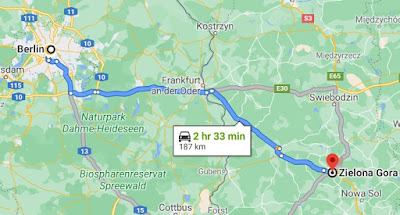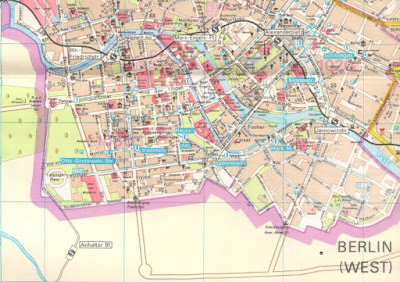East Meets West
fbb has visited Berlin but once en route to nephews wedding in Zielona Gora across the border in Poland. There was a little time for sightseeing and, of course, fbb insisted on riding Die Hunderter.
Die öffentliche Buslinie 100 startet am Bahnhof Zoologischer Garten und endet am Alexanderplatz. Sehenswürdigkeiten werden während der Fahrt nicht kommentiert, dafür ist die Tour eine kostengünstige Gelegenheit eine Stadtrundfahrt im Doppeldeckerbus zu unternehmen.
This runs from Zoo via the Brandenburg Gate (Tor in German) and is, as mentioned above, a double decker.Since those far-off days (17 years ago) the transport infrastructure has changed significantly. Notably Berlin Hauptbahnhof has appeared,The station was fully operational from 2006, built on the site of an old terminal building, the Lehrter Bahnhof.The new station sits on a crossroads of railway lines running east west and north south. The latter is in tunnel ...... whereas the historic east west tracks are in a viaduct. Both routes carry regional trains and S-Bahn (outer suburban) services all under one massive roof! Nearby is a posh new tram stop ......which looks a lot smarter from ground level.
The Hauptbahnhof also gained an Undeground station and line which opened in 2009 ...... numbered U55. Those with a passing knowledge of public transport in Berlin maybe surprised that the city had at least 55 underground lines. But all was not what it seemed.It only served three stops, terminating at the Brandenburg Gate which is almost within walking distance, even for a creaky fbb. The running time, end to end, is three minutes.
The U55 had no connection with other lines and, like London's "Drain" (Waterloo and City), trains had to be lowered by crane ...
Because the line went nowhere much and many might well decide to walk, a two car train was more than adequate for the crowds.
At Brandenburg Gate, the U55 connected with two more S-Bahn lines, but passengers could always change at Friedrichstrasse.But a later map gives the game away.The plan was always to go further east. We will pick up that narrative in tomorrow's blog.
In the meantime just a reminder of how things were at the Brandenburg Gate.So much control freakery exuded from the Kremlin that, at one time, maps of "Russian" Berlin ...... ignored the West completely - the light purple wall being an impenetrable barrier. The West wasn't much better, relegating Underground services in East Berlin to inadequately labelled thin lines and emphasising the barrier..
Politics and public transport never have mixed very well.
The "Tor" area is now beautiful and pedestrianised ...... and even after the wall came down, buses were sent "round the back" meaning that the famous route 100 allowed for just a passing view of the edifice, unlike in the olden days.You can still be reminded of those dark days for a Great City, now with a simple line of stone setts to mark the route of the wall.
Tomorrow, we see what happened to the U55 earlier last year.
The Brandenburg Gate is an 18th-century neoclassical monument in Berlin, built on the orders of Prussian king Frederick William II after the temporary restoration of order during the Batavian Revolution. One of the best-known landmarks of Germany, it was built on the site of a former city gate that marked the start of the road from Berlin to the town of Brandenburg an der Havel, which used to be capital of the Margraviate of Brandenburg.
Sigh. Another year gone ..... !






















In case it was a nearly 30-year-old memory that was at fault, I've checked the photos I took at the time that show that the 100 *did* pass through the Brandenburg Gate in 1992 - the pedestrianisation came later.
ReplyDeleteMeanwhile you would struggle to find a north-south S Bahn at Hauptbahnhof - these run further to the east, crossing the east-west route at Friedrichstrasse. The S Bahn is almost always on its own exclusive tracks (think Watford DC line) and as the aerial picture shows, only two tracks emerge to the north of the Hbf.
The East/West divide in Berlin caused havoc with public transport. I remember being on a school choir trip in 1971, which involved a journey across the city changing (I think) from U-Bahn to S-Bahn at Friedrichstrasse. Nothing strange in that, you might - except that Friedrichstrasse was in the East and interchange passengers had to follow a clearly defined route. We were given strict instructions to stay together but two lads were entranced by the sight of a Deutsche Reichsbahn Pacific standing at the head of a train at an adjacent platform. They broke away from the group to take a closer look, and were promptly detained. It took an hour of debate with a teacher to get them released ... he was furious!
ReplyDeleteTwo other memories from that trip. One is the "ghost" U_Bahn stations passed as the West German train went under the Eastern sector. The other is being told that many West Berliners wouldn't use the S-Bahn because it was administered by the DR - indeed, on some lines, trains crossed the boundary and continued on the other side although, of course, without passengers.
I recall the announcements on lines U6 and U8 “ letzte Station in Westberlin” and then the pause before the driver closed the train doors in case someone was suddenly reminded that they urgently needed to detrain . . .
ReplyDelete